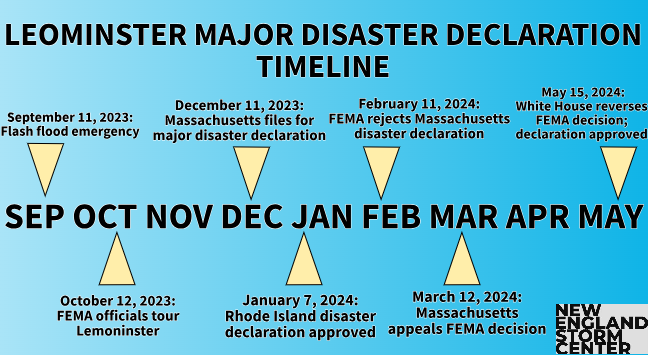Communities Across New England Continue to Deal With Flooding Aftermath
- Tim Dennis
- Aug 24, 2024
- 4 min read
Since the summer of 2023, nearly 50 towns and cities in New England have reported at least six inches of rainfall within a single storm. The most notable of these flooding events occurred on August 18, 2024; July 30, 2024; July 10-11, 2024; December 18, 2023; September 11, 2023 and July 9-11, 2023. The storms on all of these dates brought intense flooding to at least a small portion of the region. Intense flooding damage can often take weeks or months for communities to repair.

The most recent of these events came nearly a week ago, when 6-12+ inches of rain fell across southwest Connecticut. The Crisis Cleanup organization has opened a hotline for the Connecticut floods that can connect residents who are in need of help with volunteers. Among the hardest hit towns was Southbury. As of Friday afternoon, 10 roads still have closures. This is down from 60 at the height of the storm.
The Southern Baptist Disaster Relief Network is currently working within the town to assist residents in need. This organization also worked in Maine after the intense December storm. Schools are expected to open as scheduled this upcoming Tuesday as the town continues to work to repair damaged infrastructure. A tanker of potable water remains at the Town Hall.
Oxford, Connecticut, where two of the state's three fatalities occurred during the storm, saw over a foot of rain. The town may have broken the state's 24 hour rainfall record. This record is currently under review by the State Climate Extremes Committee. Unlike Southbury, Oxford has delayed the start of the school year from August 28th to at least September 3rd, though more delays could be possible. Multiple major routes remain closed in the town and multiple bridges were washed out and are in need of replacement.

All communities remain entrenched in assessment and cleanup mode. A federal emergency declaration was approved by the White House on Wednesday, which will allow agencies such as the EPA to help clear flood debris from waterways. The state is still collecting damage reports in order to file a request for a major disaster declaration from the White House, which would open the door to federal aid for homeowners and private businesses.
Nearly 1,000 residents have submitted damage reports thus far. Congressman Jim Himes has stated that damages across New Haven County must total 4.4 million dollars while Fairfield damages must total 3.9 million dollars. In order to get an estimate on totals, residents must submit photos and descriptions of the damages. Major disaster declarations often take weeks or months to be approved.
Last month, two major flood events struck Vermont, one came from the remnants of Hurricane Beryl while the other came unexpectedly, similar to Connecticut's flood this past Sunday. A major disaster declaration was approved for the July 10-11 floods this past Tuesday. Barre, one of the hardest hit cities, will open a disaster recovery center today (August 24). The center will open from 8am to 7pm seven days a week until further notice.

This past Wednesday, representatives from FEMA's recovery teams canvassed neighborhoods in Barre and St. Johnsbury. St. Johnsbury was among the hardest hit communities in the unexpected deluge in the early morning hours of July 30th. The town experienced dozens of road closures.
As of mid-August, no road closures are being reported, but some roads remain reduced to one lane. Town officials continue to ask residents to limit non-essential travel on recently damaged roads. The Caledonia County Fair donated 100% of opening night proceeds to the Northeast Kingdom Flood Relief Fund. This fund has raised over 100,000 dollars for recovery. The nonprofit will award residents up to 1,500 dollars.
On December 18th, 2023, a powerful storm tore through New England, bringing widespread wind damage and power outages. Despite this, historic flooding stole the headlines from the wind damage as Maine experienced their second worst flood on record according to the USGS. Earlier this month, Maine announced that 25 million dollars in grants would be made available to dozens of communities in the wake of several storms last winter.

Some of the communities impacted by the December flooding will receive grants, including Lewiston, who will update culverts to better withstand heavy water flows; Norridgewock, who will enhance the water transmission main and the Rumford-Mexico sewerage district, who will renovate the wastewater pumping station and install flood-proofing measures.
Last September, a stalled thunderstorm along a stalled cold front dropped over nine inches of rain on Leominster, Massachusetts. Unlike many of New England's recent major disaster declarations that were straightforward, Leominster's declaration took several twists and turns that was finally closed with an approval on May 15th, 2024, 247 days after the flooding.
The declaration was denied on February 11th after over 1,000 residents had already filled out applications. The state appealed the decision in March and the rejection was overturned when the White House overruled FEMA's ruling and approved federal disaster aid in May. The city cited damages up to 35 million dollars.

The first of these major flooding events came in the middle of July 2023, when Vermont's Great Flood of 2023 struck with damages rivaling that seen during Tropical Storm Irene. New England Storm Center recently published a detailed "one year later" article on this flood, which can be seen here.
Six inches of rain is a lot for any community in New England to handle at once, and the unfortunate club of communities who have seen this total in a 24 hour period is growing concerningly large.
Commenti